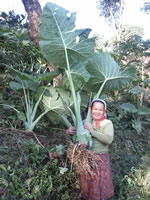Kalo is the Hawaiian name given to the cultivated plant, taro (Colocasia esculenta (L.) Schott). Kalo specifically refers to the name of the first taro growing from the planted stalk. Taro is considered by some to be the world's oldest cultivated crop. However, the common name, "taro", is also used interchangeably to refer to one of four genera in the family Araceae, the Aroid or Philodendron family. These genera include Colocasia, Xanthosoma, and Alocasia, and Cyrtosperma.
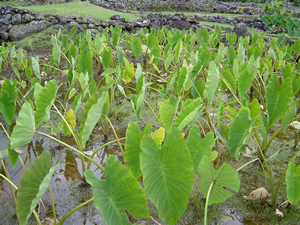
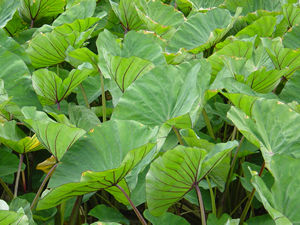
There are currently eight recognized species of Colocasia in the world, but only two are found in Hawai‘i: C. esculenta (L.) Schott and C. gigantea (Blume) Hook. C. esculenta was initially introduced to the Hawaiian Islands by Polynesians migrating to Hawai‘i, but many horticultural varieties have been introduced by humans in recent times.
Colocasia esculenta var. esculenta typically has a large central corm and develops few daughter corms.
Colocasia esculenta var. antiquorum, also called dasheen or araimo, has a smaller central corm that produces up to 20 daughter corms.
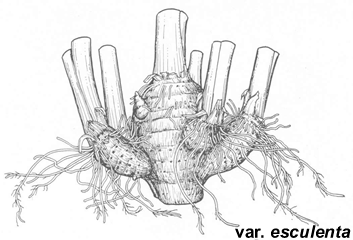
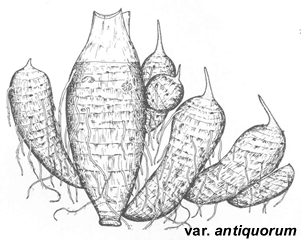
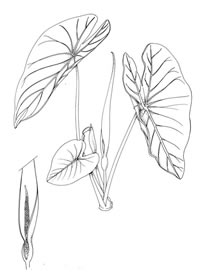 Taxonomic description of taro Acaulesent herbs up to 1 m tall. Leaf blades glaucesent on lower surface, ovate-cordate to saggittate-cordate, peltate, 25-45 cm long, 12-32 cm wide, anterior lobe 3-4 times longer than posterior lobes,
posterior lobes connate 1/3-3/4 their length, venation dark purple to yellow on lower surface, primary lateral veins 3-8 per side, petioles terete, sheathed in basal half , 40-180 cm long, green, green
splotched with purple, or purple, fading to pink near the base. Inflorescences 2-7 together, peduncles 15-50 cm long; spathe linear-lanceolate, (10-)15-40 cm long, constricted 4-6 cm from base to form a
greenish, oblong tube, the limb deflexed, yellowish; spadix exserte, 1/4- 1/3 as long as spathe, 6-14 cm long, pistallate portion up to 2.5 cm long, sterile staminate portion constricted, 1.5-5 cm long,
fertile staminate portion 2-4 cm long, with a shorter and narrower sterile appendage. Berries ellipsoid, 3-5 mm in diameter. Seeds ovoid, 1.2-1.5 mm long, 0.7-1 mm wide. [2n=14, 22, 26, 28, 30, 36,38,42, 48.]
Taxonomic description of taro Acaulesent herbs up to 1 m tall. Leaf blades glaucesent on lower surface, ovate-cordate to saggittate-cordate, peltate, 25-45 cm long, 12-32 cm wide, anterior lobe 3-4 times longer than posterior lobes,
posterior lobes connate 1/3-3/4 their length, venation dark purple to yellow on lower surface, primary lateral veins 3-8 per side, petioles terete, sheathed in basal half , 40-180 cm long, green, green
splotched with purple, or purple, fading to pink near the base. Inflorescences 2-7 together, peduncles 15-50 cm long; spathe linear-lanceolate, (10-)15-40 cm long, constricted 4-6 cm from base to form a
greenish, oblong tube, the limb deflexed, yellowish; spadix exserte, 1/4- 1/3 as long as spathe, 6-14 cm long, pistallate portion up to 2.5 cm long, sterile staminate portion constricted, 1.5-5 cm long,
fertile staminate portion 2-4 cm long, with a shorter and narrower sterile appendage. Berries ellipsoid, 3-5 mm in diameter. Seeds ovoid, 1.2-1.5 mm long, 0.7-1 mm wide. [2n=14, 22, 26, 28, 30, 36,38,42, 48.]
Thought to be native to India, widely cultivated throughout the tropics for its edible rootstock; in Hawai‘i an important crop, found persisting
outside of cultivation on all of the main islands except Kaho‘olawe (taken from Wagner et al., 1999).
Synonyms Arum esulentum L.; A. colocasia L.; Caladium esulentum (L.) Venten.; Colocasia antiquorum Schott; C. a. var. esculentum (L.) Schott ex Seem.; C. esculenta var. antiquorum (Schott) Hubb. & Rehd.
Colocasia gigantea (Blume) Hook. This giant taro species is native to China, Laos, and Vietnam. The leaf stems are used directly as vegetables. It has runners allowing it to spead rapidly.
Xanthosoma robustum Schott (syn.Xanthosoma roseum Schott) is native to Central America, and is both cultivated and naturalized in the Hawaiian Islands. It is commonly found growing along roadsides, in pastures, and in other moist to wet habitats. It can be distinguished from taro and ‘ape by its broad, dark green leaves, the tip pointing downwards, and the lobes deflexing outwards. The underside of the blade and petioles typically have a whitish, waxy bloom.
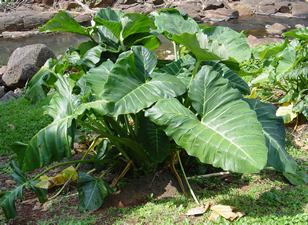
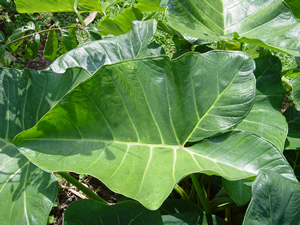
Alocasia macrorrhizos (L.) G. Don (A. macrorrhiza); Elephant's ear, ‘ape
This species can be distinguished from kalo by the much larger stature, dark green leathery leaves, and the leaf blades are vertical with the tips upright. This species was introduced to the Hawaiian Islands by Polynesians migrating to Hawai‘i. It is cultivated, but also has naturalized in low elevation mesic valleys along streams and other wet sites.



Cyrtosperma species, while being an important food crop in Malesia, is not commonly found in the Hawaiian Islands. The often gigantic Cyrtosperma species have a creeping rhizome and are heavily armoured with prickly leaf stalks. They are often found in swampy conditions. Of the twleve species in the genus, all except C. merkusii are confined to New Guinea and associated islands.


Click here for a brief history of taro in Hawai‘i.

